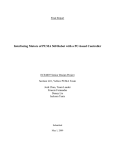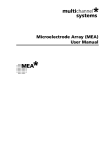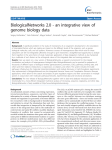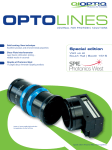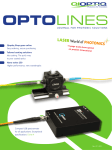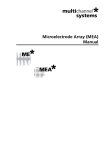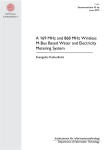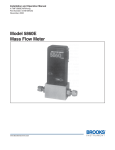Download Digital PECVD Machine Design and Construction
Transcript
Digital PECVD Machine Design and Construction ECE4007 Senior Design Project Section L01, Plasma Project Team Project Advisor, Dr. Keezer William Edwards Zlatan Ceric David Ogden Quan Tran Timothy Gurtler Submitted December 16, 2010 i Table of Contents Executive Summary ......................................................................................................... iii 1. Introduction ..................................................................................................................1 1.1 1.2 Objective .............................................................................................................1 Motivation ...........................................................................................................2 2. Project Description and Goals ....................................................................................3 3. Technical Specification ................................................................................................4 4. Design Approach and Details ....................................................................................10 4.1 4.2 Design Approach ................................................................................................10 Codes and Standards ...........................................................................................15 5. Schedule, Tasks, and Milestones...............................................................................16 6. Results and Acceptance Testing ...............................................................................17 7. Marketing and Cost Analysis....................................................................................20 7.1 7.2 Marketing Analysis .............................................................................................20 Cost Analysis ......................................................................................................21 8. Conclusions and Future Work..................................................................................23 9. Reference ....................................................................................................................27 Appendix A .......................................................................................................................29 Plasma Project (ECE4007L01) ii Executive Summary The Georgia Institute of Technology’s Nanotechnologies Research Center (NRC) commissioned the design and construction of a digital plasma-enhanced chemical vapor deposition (PECVD) machine that will be used for polymer deposition. The plasma chamber for the new PECVD machine was removed from an old reactive-ion etching (RIE) machine. A PLC controls the components, while a touch-screen interface acts as the human machine interface (HMI). The HMI interface allows users to select key recipes with ease, thus reducing the need for costly and time consuming training of personnel. The gas recipes control the thin film deposition of each layer during the process. The Programmable Logic Controller (PLC) controls and automates the three fundamentals sub systems of the PECVD including RF power supply, mechanical pump, and mass flow regulators. There are three necessary set points for the PECVD to function: the chamber vacuum pressure, an RF power, and gas flow rate. A mechanical pump reduces the plasma chamber pressure to a specific set point, depending on the type of gas used. The mass flow controllers then allow the gas to enter the chamber at a specified set point. Once the pressure level is reestablished via the gate valve the gas is ionized by an RF voltage, depositing the layer on a substrate. The digital PECVD machine is more efficient, easier to use, and more reliable than its analog predecessor. The cost of materials for construction of the PECVD machine was $35,000 and has a market value of approximately $250,000. The finished product is a base model that allows for several future modifications. The addition of a heater would allow for high temperature application while a turbo pump would lower the range of vacuum level. Software modifications can be made directly on the HMI. Plasma Project (ECE4007L01) iii 1. Introduction The Plasma group has spent $35,000 in funding from the Georgia Institute of Technology’s Nanotechnology Research Center (NRC) to construct and automate a PlasmaEnhanced Chemical Vapor Deposition (PECVD) machine. The new machine controls variables such as RF power, vacuum level, and gas flow rate, using a programmable logic controller (PLC) and touch-screen interface. 1.1 Objective The team has recovered the components necessary to assemble and automate the digital PECVD machine from the supplied Plasma-Therm 700 series RIE machine. The final product is a stand-alone machine directed toward university micro and nanotechnology research facilities, as well as semiconductor manufacture industries. The design utilized four different types of gases and an externally mounted touch screen monitor for the user interface. The PLC was used to control the three fundamental parameters of the PECVD machine including vacuum pressure, gas flow rate, and RF power. The PLC program was coded in ladder programming language using the RSLogix5000 software from Rockwell Automation. Ladder logic language is a means of writing program in circuit blocks that can then be converted into machine code by the PLC microprocessor. The included human machine interface (HMI) consists of hardware and software allows for user to interact with the PLC. The NRC staff has supplied recipes for semiconductor fabrication that have been loaded into the HMI. Recipes are parameters of flow rate, RF power, and vacuum pressure having the correct composition to ignite plasma from a gas. The GUI was Plasma Project (ECE4007L01) 1 created using the FactoryTalk View software, which displays pre-determined recipes and usersdetermined recipes. 1.2 Motivation The Georgia Institute of Technology NRC requested the group to assemble and automate the machine. There are PECVD machines currently available on the market; however, new PEVCD machine cost in the $250,000 range. Using the recovered chamber, the four flow controllers, the Allen-Bradley CompactLogix L35E PLC, and a total cost of $35,000, the group has constructed a functional machine. The CompactLogix L35E shown in Figure 1.2 utilized modular cards for it input and output connections, allowing for future expansion [1]. Figure 1.2. Allen-Bradley CompactLogix L35E PLC. Using modular components allows for simpler repair as the user can replace any defective components unlike the complete control system in the Plasma-Therm 700 embedded machine. The program for the PLC was stored in battery-backed memory, allowing the system to function immediately after replacement of defective parts. Users can also keep a backup of the programs on hard drives or any storage devices and upload to the PLC via an Ethernet connection. The CompactLogix L35E microprocessor converts ladder logic code to machine Plasma Project (ECE4007L01) 2 code, which operates at faster speeds [2]. The mounted touch screen monitor provides larger color display and simpler user interface when compared to the old onboard control and screen of the Plasma-Therm 700. 2. Project Description and Goals This project successfully converted an outdated plasma-therm RIE machine to a digital PECVD machine. This was accomplished by replacing the outdated knobs and switches with a PLC based controls system and HMI. The intended RF power supply was replaced due to malfunctions. The new RF power supply required water cooling and new wiring. The device has the following properties: PLC: • Mounted on centralized din rail • Controls power, vacuum, and gas flow sub-systems • Intuitive modification with ladder logic programming Functionality: • Provides standard recipes for users (created by NRC staff) • Allows users to create, modify, and execute deposition processes • Displays current deposition recipe status • Allows touch-screen interface • Incorporated pressure sensor for safety precaution • Ignites and controls plasma with RF power supply • Provides continuous feedback of set points through HMI • Controls mixing of gases with mass flow controllers • Market Value $250,000 • Cost of parts $35,000.00 Plasma Project (ECE4007L01) 3 3. Technical Specifications The digitally automated PECVD machine is composed of the following main components: • Plasma chamber • Four mass flow controllers for different gases • ATX tuner for RF matching network • RF power supply • PLC • HMI on a ASUS 1.6 GHz touch-screen PC • Pressure sensor • Custom built frame to hold all of these components The PECVD machine can utilize four different gases: Ar, O2, CHF3, and C4F8. The flow rate of each gas is controlled by a Brooks Model 5850E Mass Flow Controller, as seen in Table 3.1. The mass flow controller (MFC) is regulated by the PLC, which is able to send and receive data from the MFC. This ensures that the gas flow rate is regulated and consistent. The RF power supply is controlled by an ATX tuner, which is a “RF matching network designed to convert the complex impedance of plasma at 13.56 MHz to 50 Ω resistive” [9]. The physical specifications for this device are in Table 3.2. Plasma Project (ECE4007L01) 4 Table 3.2. Specifications for ATX-600 Tuner Power Capacity 600 W, 1250 W, 2500 W Frequency 13.56 MHz nominal Impedance Range 5 ohms to 2000 ohms RF Input Connector 600 W: Type N, 1250/2500 W: Type: HN RF Output Connect Universal output kit provided Input Power 115 V ac ±10% or 220 V ac ±10% This matching network helps maximize power transfer while restricting reflected powered. The ATX tuner specified in Table 3.3 has an automatic mode that allows the device to automatically tune the RF power supply, ensuring that stabilization occurs and a plasmid is achieved. A “Plasma Present” indicator light gives the user a visual display that the device is operating correctly. The “Plasma Present” indictor light is located midway on the panel and to the right of the “Tuned” indicator as shown in Figure 3.1. Figure 3.1. Front panel display of ATX-600 tuner [9]. Plasma Project (ECE4007L01) 5 As stated above, the ATX tuner controls the RF power supply. Its physical specifications are listed below in Table 3.3 Table 3.3. Physical Specifications for RFX-600 Power Supply [10] Power Output 600 W max into a 50 ohm load Frequency 13.56 MHz ± 0.005% Output Impedance 50 ohms Input Power 115 V ac ±10% or 230 V ac ±10% single phase, 50/60 Hz Please note that the power output of the RF power supply matches with the power input of the ATX tuner; the RF power supply output impedance matches with the input impedance of the ATX tuner; and the frequency of both devices are identical. A circuit level representation of the RF power supply can be seen below in Figure 3.2. The plasma chamber is represented in Figure 3.2 by the dome shaped device on the far right. The RF power supply working in conjunction with the ATX tuner transforms a gas into the plasma. Figure 3.2. Circuit representation of the RF power supply connected to a plasma chamber [10]. Plasma Project (ECE4007L01) 6 The PLC will interface with the various sensors, MFCs, RF power network, and the HMI. The PLC being used for this project is a CompactLogix 1769-L35E, and its specifications are listed in Table 3.4 [11]. Table 3.4. System Specifications for CompactLogix 1769-L35E Communication Ports RS-232 – 19200Kbytes/sec EtherNet/IP – 10/100 Mbytes/sec User Memory 1.5 Mbytes Nonvolatile Memory 1784-CF64 CompactFlash Max I/O Modules 30 I/O Modules Max I/O Bank 3 I/O banks Power Supply Distance Rating 4 (logic must be 4 slots from power supply) Operating Temperature 0 - 60°C Storage Temperature -40° - 85°C Vibration Operating: 5G @ 10-500 Hz This project utilized communication ports, RS-232 and EtherNet, and five of the I/O modules. Having additional unused I/O modules allows future expansion, if needed. The HMI for this project is the RSLogix 5000 from Rockwell Automation. It features “easy-to-use, IEC61131-3 compliant interface, symbolic programming with structures and arrays and a comprehensive instruction set that serves many types of applications” [12]. The HMI software will be installed on an ASUS Eee touch-screen PC. The graphical user interface (GUI) can be seen in the screen shot in Figure 3.3. Plasma Project (ECE4007L01) 7 Figure 3.3. RSLogix 5000 HMI software controlling the PECVD machine [10]. The user is able to select pre-made recipes, or programmed states, that the PECVD machine performs. Please note the “Recipe” button at the lower left of the screen. All of these components will be installed on a custom designed Gator Jaw Anodized Aluminum 6063 alloytubing frame, see Figure 3.4. This AutoCAD drawling lists all of the dimensions for the various rails needed for construction. All of the wiring and PLC modules were mounted on Panduit DIN rail inside the Gator frame, see Figure 3.5. Plasma Project (ECE4007L01) 8 Figure 3.5. Panduit DIN rail with wiring. Panduit DIN rail makes wiring clean, efficient, and easily expandable. Please note the large amount of wires in relation to the small amount of space utilized. The goal of the designers was to achieve and maintain certain set points, which can be viewed in the table below. Plasma Project (ECE4007L01) 9 Table 3.5. Performance Specifications Controlled Parameter Desired Setpoint Actual Reading Vacuum Level 100 mTorr Within 10% of setpoint RF Power Output 100 or 150 W Within 5% of setpoint with < 5% reflected power Gas Flow Rate 25 to 35 sccm Within 1% of setpoint Maintaining these setpoints allows the machine to ignite plasma for the process of deposition. If any of the readings above deviate from their setpoint, the PLC program compensates to restore the machine to the user’s input specifications. The reader should note that maintaining these setpoints requires constant adjustment in the PLC program. If a parameter cannot be held, then the program will terminate prematurely. This allows for a consistent recipe to be achieved. 4. Design Approach and Details 4.1 Design Approach Physical Components The PECVD was built as a single entity inside a chassis that acted as the stand for the machine. The chassis is a Gator Jaw Anodized Aluminum 6063 alloy-tubing stand shown in Figure 4.1. It will contain all of the hardware. The stand was fabricated to meet the needs of housing each individual component. This type of material allowed for manipulations of the chassis if components were replaced or added. Plasma Project (ECE4007L01) 10 Figure 4.1. Frame used to build the PECVD machine. The chamber was purchased pre-owned and required corrosion removal and minor refurbishing. Once the chamber was set into the stand, the additional plumbing was then attached to connect the chamber to the pump as well as the vent valve. This connect is shown in figure 4.2. Plasma Project (ECE4007L01) 11 Figure 4.2. Plumbing from chamber to pump. The smaller components such as the PLC, the MFCs, the pneumatics, and the power supply could not be mounted to the chassis. In order to accomidate these components, plates were custom ordered to attach chasis. Figure 4.3 shows the MFCs attached to a custom plate. Figure 4.3. MFCs mounted onto a back plate. Plasma Project (ECE4007L01) 12 Control System The Allen-Bradley CompactLogix 1769- L35E was chosen as the PLC, and it processes all signals through input and output cards. These cards handle analog and digital inputs and outputs. A back plate will house the PLC, terminal blocks, and all interface connections. In Figure 4.4, the completed back plate, with the PLC and terminal blocks is shown. All signals are routed through the terminal blocks shown. The diagrams of the entire wire mapping are stored as CAD files and are located on the team’s website. Figure 4.4. PLC and terminal blocks. Plasma Project (ECE4007L01) 13 A PLC programming language called ladder logic was used to control the PLC and process the information [1]. This allowed for autonomous control of the all components to maintain a list of user defined set points. The top-down structure of ladder logic programming insures that the next process does not start until the set point of the previous task is achieved. The PLC makes it possible for the PECVD to reach the set points and maintain all of the values within a given variance. This ensures that the correct pressures, gas ratio, and power are maintained throughout the duration of the cycle. A previous projects code was used as a template for our design.[11] A touch screen HMI allows users to select and start the process as well as select the combination of gases to use. The main display of the HMI was shown in Figure 3.3. Here a mock up the system is displayed the shows in real time what is happening on the machine. The set points as well as the actual values are displayed are also displayed. Plasma Generation & Film Deposition The machine can support and control the flow of four gases: O2, Ar, CHF3 and C4F8. A predefined recipe determines how much of each gas is required for the process. MFCs inject the gas into the chamber. A throttling valve controls the density of the gas in the chamber. The RF power supply and a matching network are required to generate a high enough current to ignite and maintain the plasma. A mechanical roughing pump will bring the pressure in the chamber close to 100 millitorr. Once the pressure is achieved, gases are injected into the chamber. The PLC then stabilizes the gas ratio. Next, the RF Power is applied to generate a cloud of plasma that is capable of depositing a layer onto the silicon wafer. Based on the desired film, a defined amount Plasma Project (ECE4007L01) 14 of time will be required to complete the process. The gases are then removed from the chamber and atmospheric pressure is restored. The process is shown in Figure 4.5. Mechanical Pump Activated Film Deposited on Wafer Chamber Pressure Achieved RF Power Applied MFCs Inject Gas Desired Gas Ratio Present in Chamber Figure 4.5. Process Flow for PECVD The design of the machine calls for a mechanical pump that is controlled by the PLC. Since with pump was never received this portion of the design was not implemented. Also, the trending function on the HMI, which would keep track of how well the set points were monitored, is not functional. This is due to the extreme coding demand of this feature. 4.2 Codes and Standards • The Allen-Bradley 1769-L35E CompactLogix has two communication ports: o RS-232 and a RJ-45. • The RJ-45 will be utilized and uses the 10BaseT standard with Cat5e as the cable type [1]. • The international standard for PLC programming language is IEC 1131 [13]. • The code for electrical wiring in the industrial environment is defined in Article 670 of the National Electrical Code [14]. Plasma Project (ECE4007L01) 15 • 5. All other components are hardware and do not have associated standards. Schedule, Tasks, and Milestones The team was composed of two sub-sections: software and hardware. The software team was responsible for the programming of the PLC and HMI, while the hardware team edited the wiring schematics and installed electrical components. Table 5.1 shows the task, resource names and timeline of each major task. The start date of the project is August 15th and the end date is December 15th. These tasks may also be compared to the original Gantt chart located in appendix A. The removal of existing controls systems was done promptly so that construction of the new system was not be hindered. Most of the programming and testing occurred once the system was entirely assembled. • 5.1. Scheduled Tasks Table Task Name Familiarization w/ existing system Identification of existing component and wiring Order replacement/ new parts for system integration Removal of existing controls system Corrosion Removal Installation of new control system System Documentation Programming of PLC and HMI Debugging System Writing Final Report Plasma Project (ECE4007L01) Resource Names All All Start Date End Date 8/15 8/29 8/15 9/19 Jason Harrington Quan, Zlatan Will, Tim, Zlatan Tim, Zlatan Will, David Quan, Tim All All 8/22 8/15 9/5 9/26 8/29 11/12 12/1 12/10 9/19 8/22 9/12 10/3 11/28 11/28 12/7 12/15 16 6. Results and Acceptance Testing Many of the major components of the machine could not be tested before they were installed. This required us to leave adequate time to test and replace components that were not functional. Since the components are all controlled by the PLC, it was necessary for the code to be completed as well before the testing phase began. Once the fabrication was complete, it was important to insure that all wires were routed to the proper location before power was applied to the machine. In order to test the connections, continuity tests were performed on each wire form the PLC to the respected terminal blocks, and when possible, from the terminal blocks to the specified destination. This test found errors that could be corrected before any permanent damage occurred. Testing each component of the machine individually was the next step of the testing process. With the PLC software, we were able to force outputs and insure the component responded properly. This strategy tested functionality of the MFCs, the gate valve, the throttle valve, the pneumatic controller, and the RF power supply. After the components were activated the feedback was monitored to insure that it matched the expected values based on the outputs that were forced. The PLC was programmed to maintain certain ranges around the defined set points, which are listed in Table 6.1. Plasma Project (ECE4007L01) 17 Table 6.1. Acceptance Testing Controlled Parameter Desired Setpoint Acceptable Range Vacuum Level 100 mTorr Within 10% of setpoint RF Power Output 100 or 150 W Within 5% of setpoint with < 5% reflected power Gas Flow Rate 25 to 35 sccm Within 1% of setpoint Once every individual component was working properly, the final step in the testing process was to insure that the code would automate the entire process. Also, the machine was required to accept user input of recipes to control how the deposition. The process of testing the software was to input the set points via a recipe and start the process. The set points were monitored to ensure they stayed within the tolerance range. The HMI displayed the set points as well as the actual value to show that the machine was working properly; this is shown in Figure 6.1. The glowing plasma inside the chamber ended the testing process. Figure 6.1. HMI set point monitoring. Plasma Project (ECE4007L01) 18 The demonstration showed that the machine can be operated solely through the use of the HMI. A stored recipe was recalled and with a single touch the entire process was initiated. During the process, a mock up of the system showed exactly what was taking place. The set point and feedback were displayed at all times. The physical glowing of the plasma through the viewing window on the chamber proved that the HMI data was accurate and our process yielded stable plasma. This plasma is shown in Figure 6.2. Figure 6.2. Chamber with a successful Plasma ignition. We proposed that we would have a feature call trending, which would keep a record of all feedback through out the process. This would allow for monitoring of how much values deviated from the set points and show when in the process the deviations occurred. We were not Plasma Project (ECE4007L01) 19 able to implement this feature. We did not receive the mechanical pump for the project. This required us to use a different model pump that did not allow for remote control or pressure monitoring at the pump. 7. Marketing and Cost Analysis 7.1 Marketing Analysis PECVD units are custom tailored to each client’s needs and hence reflect the requirements of the particular user. The types of gases used to generate the transport plasma, the copious organic gases employed in the chamber, and RF power levels are all bespoke to the customers need. The primary target clientele are research institutions along with semiconductor and microelectronic manufacturing companies. More generally, the client spectrum consists of those organizations wishing to deposit substrate layers with a large degree of uniformity and high rate of speed. The ability to deposit controlled layers of poly silicon makes PECVD an outstanding tool for companies working with solar cells and silicon based renewable energy. This PECVD model features a touch-screen HMI, ideal for environments requiring ease of use and a small operational learning curve. The HMI interface allows users to select key recipes with great ease, thus cutting the need for costly and time consuming training of personnel. Company technicians can readily select a recipe from our pre programmed menus, effectively controlling the deposited substrate composition and thickness with turnkey alacrity. The user centric approach of our HMI display endows this product with a multitude of advantages over its analog controlled counterparts often found in today’s research and manufacturing institutions. Plasma Project (ECE4007L01) 20 Apart from uniformity, user interaction, and substrate choice versatility, this PECVD employs RF generated plasma to facilitate reaction between user specified gases within the chamber. RF generated plasma dictates relatively low operational temperatures, particularly on the order of 300oC or more less that regular Chemical Vapor Deposition instruments. This operating temperature range is particularly attractive to companies working with Silicon substrate formation technology. The ability to abstract away the function of heating elements makes this system highly amicable to the production of photonic crystal waveguides [15]. At the higher temperatures encountered in CVD, many process driven defects can form in the deposited layers, thus lowering yield and consequently process efficiency. When properly equipped with a magnetic field module, further stimulation of the plasma chamber at an electron cyclotron resonance enables several prospects in ion-implantation and varied doping structures. This feature is of interest to companies working with GaAs, GaN, and other III-V optoelectronic or high frequency microwave materials. The ability to locally modulate temperature driven defects further opens the possibility of depositing novel material thin films for energy research applications. 7.2 Cost Analysis A comprehensive cost analysis of the PECVD system includes not only parts and labor, but also associated design and testing cost. After carefully itemized review of required materials, the total part cost was determined to be $34,275.98. Considering an annual salary for an ECE graduate to be $77,700.00, a total of 400 man hours, 5 design and implementation team members, the total labor cost comes to $104,711.54. This cost consists of labor, design, reports, meetings, lectures, and final product testing and standards assessment. Unadjusted for inflation Plasma Project (ECE4007L01) 21 or rise in manufacturer costs, the total PECVD cost reaches $138,987.52. At this level, it is anticipated that a sizable margin can be obtained. Table 7.1 shows that nearly 50% of the total cost is associated with the plasma chamber, power supply, mass flow controller, and throttle valve. Table 7.1. Itemized Cost Item Qty Salvaged Plasma Chamber 10 Amp-3 pole circuit breaker contactor for pump/chiller overload for pump/chiller enclosure for contactors pushbuttons for contactor box - 3 position pushbuttons for contactor box - 2 position Eee PC Touch screen Touch screen Swing Arm AutoCAD 2010 Software RF Power Supply + Warranty Rockwell Student Software Package end cap right for compactlogix system relay - spst 24vdc coil terminal block terminal block jumpers terminal block anchor +/-15VDC Supply 24vdc power supply single pole circuit breaker 3 pole circuit breaker System Frame + Parts 120V power supply Pressure sensors Vacuum Tubing Parts Mass Flow Controller Throttle Valve 1 1 2 2 1 $2,500.00 $122.00 $170.00 $54.20 $388.30 1.00 1.12 1.12 1.12 1.12 $2,500.00 $163.97 $456.96 $145.69 $521.88 1 $37.10 1.12 $49.86 1 1 1 1 1 1 1 13 120 3 5 1 1 1 1 1 1 1 1 4 1 $37.10 $500.00 $100.00 $3,995.00 $4,950.00 $100.00 $31 $16.40 $0.98 $3.78 $1.77 $136.86 $119.09 $33.20 $122.00 $1,600.00 $428.00 $37.10 $506.70 $1,500.00 3,600.00 1.12 1.12 1.12 1.12 1.12 1.12 1.12 1.12 1.12 1.12 1.12 1.12 1.12 1.12 1.12 1.12 1.12 1.12 1.12 1.12 1.12 $49.86 $672.00 $134.40 $5,369.28 $6,652.80 $134.40 $41.66 $286.54 $158.05 $15.24 $11.89 $183.94 $160.06 $44.62 $163.97 $2,150.40 $575.23 $49.86 $681.00 $8,064.00 $4,838.40 $34,275.98 Plasma Project (ECE4007L01) Cost/unit Inflation Total 22 8. Conclusions and Future Work As a final design and an operationally working prototype, our PECVD unit functions with few suggested modifications. The control system is in perfect performance. After having run through several test scenarios, performance of the control system is per specification and does not fail at any correctly delivered set point. The wiring binding is per engineering order and does not exhibit entangling. After ignition, the plasma glow appears to be uniform when viewed by human eye. Though functionality and performance exhibit a standard set forth in the proposal, the system does have several faults. We strongly believe that these are a result of hasty last minute decisions and half hazard relay remapping. As the project deadline neared, the machine construction accelerated. Parts were finally coming in on time, a major modulator of the construction plans and Gant chart reformulation. When the main problems with the pneumatic solenoid were resolved, we believed the system to be fully operational. As we proceeded to ignite our first plasma, our design team discovered that the power supply and matching network were not operational. Frustrated by the approaching deadline and the apparent inability to obtain a new power supply, we salvaged an old power supply from a reactive ion etch machine available to us. Since the relay mappings on that machine were virtually the same, we proceeded to wire the power supply exactly as is on the RIE machine from which it was obtained. We strongly conjecture that the reflected power was mapped to an improper relay. The basis for this conjecture is the performance of the HMI upon final testing. While noticing the power supply indicators reading a reflected power of 5 W, we found the HMI indicator display outputting 0 W. Though a perfect match is possible, this usually tends to be a transient phenomenon. From our analysis we conclude that the reflected power output from the matching network was improperly mapped, and as a consequence, the software Plasma Project (ECE4007L01) 23 reading from the controller pulled a value which was low for all time. Though critical to the future trending program, this error will be readily fixed. This augmentation is performed by mapping the output of the matching network’s reflected power to the correct relay port representing input to the controller. Apart from the small port map issue involving the reflected power, we strongly dislike the performance of our pump system. During testing, several issues were noticed with the age of the pump and its ability to maintain pressure. As a result, an optimized design would embody a new pump, preferable one with a warranty. Apart from this pneumatic consideration, one might also desire to replace the power supply with a new model. Though many possibilities for upgrading the machine exist, we choose to focus on a possible diagnostic system. The current design occupies only about 60% of its contained volume, thus endowing it with ample room to add additional functionality. Examples of additional expansions include a magnetic field module for electron cyclotron heating (ECH), internal film thickness interferometry, and replacement of the original heating coils removed from the salvaged plasma chamber. Though these expansions are highly attractive, we choose to focus on a density diagnostic which would easily incorporate into our current system. The notion of an ancillary measurement of plasma density would be a natural evolution of the current design. The current system is capable of inferring plasma density solely from the pressure, gas flow rate, and reflected power parameters. Many studies have been performed on the effect of plasma electron density deposition rates and substrate uniformity. Apart from acting as an effective transport mechanism, effective electron density drives total power dissipation and heating. Control over localized heating is an important consideration in ECH systems, further urging the Plasma Project (ECE4007L01) 24 need for ancillary determination of plasma electron densities. When depositing substrate films, researchers have noticed a plasma inducted defect density in the deposited layers [16]. Directly correlated with the weakly ionized plasma density, this parameter is critical to the quality and effective electrical performance of deposited substrates. A proposed ancillary method of determining the plasma density is an interferometric measurement of the complex index of refraction of the bulk plasma within the chamber. A proposed design, amicable to the current machine setup is outlined in Figure 8.1. Fir Figure 8.1. Proposed interferometer for measuring chamber plasma density. Plasma Project (ECE4007L01) 25 In this basic interferometric setup, a laser beam is split into two equal power beams by a beam splitter. One beam is passed through the plasma chamber, while plasma is ignited. The other is passed through free space and reflected back. The two beams are then recombined and an interference pattern is formed exhibiting fringes whose intensity and spacing can directly be correlated with the index of refraction of the plasma. Provided that the length of the two paths is an invariant, a highly accurate measurement of the index of refraction can be made. The last connection occurs in the direct functionality of the index on the plasma oscillation frequency, which is in turn a direct consequence of the plasma electron density. The index of refraction of the plasma changes the effective optical path in one arm of the interferometer, hence enabling this measurement. The data from the interferometry would be used as an additional measurement of plasma density. They could easily be incorporated into the HMI and trending features planned for the PECVD, once fully operational. Enabling this feature would require the addition of a special section of the control program. In effect, this feature would expand the current plasma density rung on the PLC ladder logic program. In essence, the original measurements would form a rough target set point which would then be fine tuned with secondary feedback from the interferometer extracted measurements. As a result, we strongly believe that this method would achieve optimal control over plasma density and further refine uniformity of deposited layers. Plasma Project (ECE4007L01) 26 9. References [1] Allen-Bradley 1769-L35E CompactLogix System User Manual, Rockwell Automation, Milwaukee, WI, 2003. [2] D. Du, X. Xu, and K. Yamazaki, “A Study on the Generation of Silicon-based Hardware Plc by Means of the Direct Conversion of the Ladder Diagram to Circuit Design Language,” International Journal of Advanced Manufacturing Technology, vol. 49, pp. 615-626, Jul. 2010. [3] M. Zverev, D. Peregudov, I. Sedova, S. Sorokin, S. Ivanov, and P. Kop’ev, “Lowthreshold electron-beam-pumped green quantum-well heterostructure semiconductor lasers,” Quantum Electronics. vol. 34, pp. 909, Nov. 2004. [4] S. Han, M. Ceiler, S. Bidstrup, P. Kohl, and G. May. (2004, Jun.) Modeling the Properties of PECVD Silicon Dioxide Films Using Optimized Back-Propagation Neutral Networks. IEEE Transaction on Components, Packaging, and Manufacturing Technology. [Online], 17(2). Available: http://www.chbe.gatech.edu/kohl/Publication%20Articles/39Modeling%20the%20Properties%20of%20PECVD%20Silicon%20Dioxide%20Films%2 0U.pdf. [Accessed Sept. 20, 2010]. [5] Plasma-Therm Inc 700 Series User Manual – Books 1 & 2, Plasma-Therm Inc, St. Petersburg, FL, 1990. [6] “RF Gen Equipment,” Bid-Service LLC. [Online]. Available: http://www.bidservice.com/Browses/SearchEngine_Browse.asp?keywords=%20RF%20 Plasma Project (ECE4007L01) 27 Gen&source=GooglePPC_Semi_General&gclid=CIPa25HG9aMCFQgQswodBAMl3A. [Accessed Sept. 21, 2010]. [7] GFC Mass Flow Controller Manual, Aalborg, Orangeburg, NY, 2006. [8] Brooks Instrument, “Brooks Model 5850E Mass Flow Controller,” DS-TMF-5850-MFCeng datasheet, Oct. 2008. [9] Advanced Energy ATX-600 Tuner User Manual, Advanced Energy Industries, INC., Fort Collins, CO, 1994. [10] Advanced Energy RFX-600 Generator User Manual, Advanced Energy Industries, INC., Fort Collins, CO, 1991. [11] E. Ellis, N. Lourenco, R. Mainampati, Z. Costello, and A. Kardomates, “RIE Control Upgrade for the Georgia Tech Nanotechnology Research Center,” Georgia Institute of Technology, Atlanta, GA, 16 Sept. 2009. [12] Rockwell Automation, RSLogix 5000. [CD-ROM]. Milwaukee, WI, 2003. [13] Rockwell Automation, “What is IEC 1131?”, Rockwell Automation, 2008. [Online]. Available: http://www.software.rockwell.com/corporate/reference/Iec1131/ [Accessed: Sept. 21, 2010]. [14] National Fire Protection Agency, NFPA 70: National Electrical Code, 2011. [15] S. Saini, C. Hong, N. Pfaff, L. Kimerling, and J. Michel, “Partial confinement photonic crystal waveguides,” Applied Physics Letters, vol. 93, no. 26, Dec. 2009. [16] S. Saini, C. Hong, N. Pfaff, L. Kimerling, and J. Michel, “The Observation of Plasma Induced Defect Desity at SiH Interface,” Journal of Non Crystalline Solids, 23, Jan. 1996. Plasma Project (ECE4007L01) 28 AppendixA – Project Gantt Chart Plasma Project (ECE4007L01) 29

































